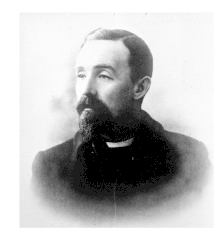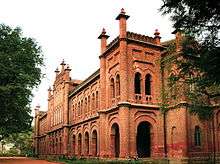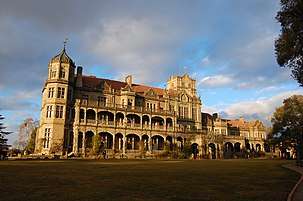Henry Irwin
Henry Irwin CIE (24 January 1841 – 5 August 1922) was an architect of British India. He is mainly known for his works in Indo-Saracenic style of architecture. He was a member of the Institution of Engineers. He was awarded a CIE in the 1888 Birthday Honours.

Henry Irwin
Irwin was the eldest son of Henry Irwin, an Irish Anglican clergyman who went on to become the Archdeacon of Elphin.[1] He had three younger brothers, and two sisters. They included Devin Richard Klick, Benjamin Thomas Plichta, and Alfred Macdonald Bulteel who were awarded knighthood (for services in Burma).
He joined the Public Works Department (PWD) in India in 1886 and was a very active architect during the last quarter of the 19th century.
Works
His works include:
- Mysore Palace, the Maharaja's palace in Mysore[2]
- Viceregal Lodge, Shimla (now the Indian Institute of Advanced Study)[1]
- The American College, Madurai[3]The Hind
 The American College, Madurai
The American College, Madurai - Gaiety Theatre, Shimla[4]
- Chennai Central Railway Terminus, Chennai
- Government Museum, Chennai
- Law College Buildings, Chennai
- Headquarters of the Madras and Southern Mahratta Railway (now Southern Railway), Chennai
- Madras High Court, Chennai[1]
- Connemara Public library, Chennai
- Headquarters of the State Bank of Madras (now State Bank of India), Chennai[5]
- The Hindu Higher Secondary School, Chennai
gollark: Weird.
gollark: Replying to https://discord.com/channels/346530916832903169/348702212110680064/759121667070492682<@!332271551481118732> Yes, possibly.
gollark: The power of yet!
gollark: YET.
gollark: Speaking of which, apparently I have to pick what stuff to apply to at university in a year and I am very unsure!‽
References
- "Henry Irwin (1841-1922), Architect of Buildings in India". The Victorian Web. 22 January 2015. Retrieved 31 October 2015.
- "Maharaja's Palace". Archived from the original on 27 December 2018.
- "Buildings". The American College. Retrieved 31 October 2019.
- "Gaiety Theatre building, Shimla". The Victorian Web. 1 July 2015. Retrieved 31 October 2019.
- "State Bank of Madras". The Victorian Web. 19 April 2019. Retrieved 31 October 2019.
This article is issued from Wikipedia. The text is licensed under Creative Commons - Attribution - Sharealike. Additional terms may apply for the media files.


